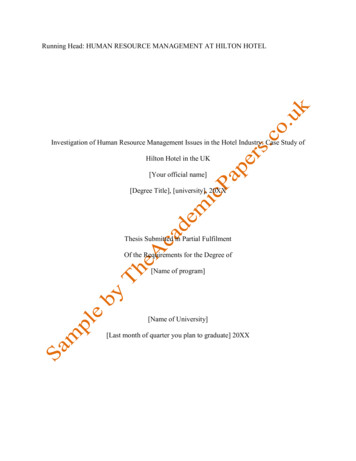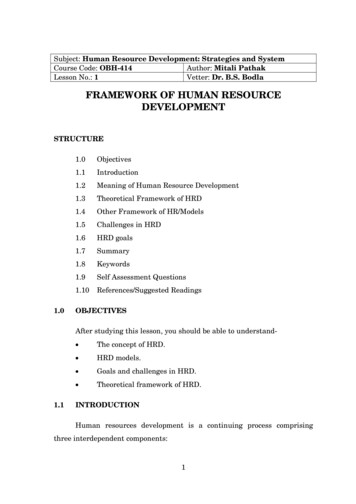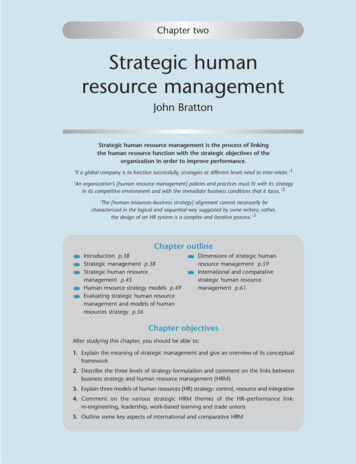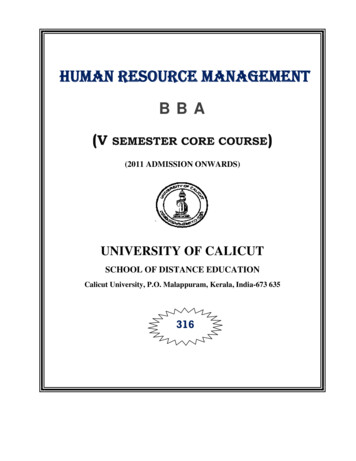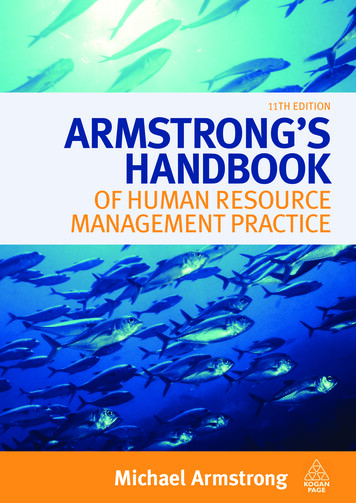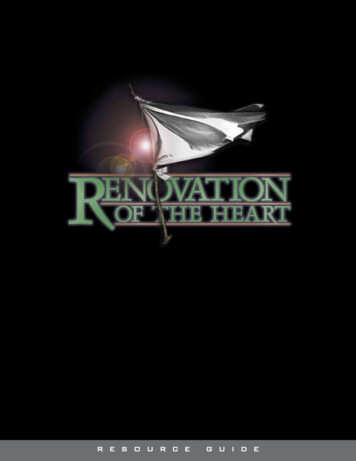
Transcription
R E S O U R C EG U I D E
RESOURCE GUIDE
Books By Gary Moon/Other Resources Video CurriculumGod Views: Seeing Clearly the One Who Loves You Most Family Devotion/Children’s CurriculumThe Bible Ride: Adventures That Bring the Gospel to Life (Volumes 1-4)The Bible Ride Atlas (Volumes 1-4)The Bible Ride Scenic Route (Volumes 1-4) Also by the AuthorHomesick for Eden: A Soul’s Journey to Joy To Contact the PublisherWeb:www.lifesprings.netPhone: 1.800.541.1376Address:LifeSprings ResourcesP. O. Box 92425 West Main StreetFranklin Springs, GA 30639-0009Last updated July 20132013099
RENOVATIONOF THE HEARTResource GuideWritten by Gary W. MoonDesign & Development by Jeffrey Hayes Johnson
Renovation of the Heart Resource GuideCopyright 2003 by Gary W. MoonRequests for information should be addressed to:LifeSprings ResourcesP.O. Box 9Franklin Springs, GA 30639ISBN: 0-911866-69-8All Scripture quotations, unless otherwise indicated, are taken from the Holy Bible:New International Version. NIV. Copyright 1973, 1978, 1984 by International BibleSociety. Used by permission of Zondervan Publishing House. All rights reserved.All rights reserved. No part of this publication may be reproduced, stored in a retrievalsystem, or transmitted in any form or by any means—for example, electronic, photocopy, recording—without the prior permission of the publisher.Cover illustration, interior art and design by Jeffrey Hayes JohnsonCopyright 2003 by Jeffrey Hayes JohnsonPrinted in the United State of America
Contents:Introduction. . . . . . . . . . . . . . . . . . . . . . . . . . . . . . . . . . . . . . . . . . . . . . . . . . . . . . . . . . . . . . . . . . . . . . . . 7Foreword. . . . . . . . . . . . . . . . . . . . . . . . . . . . . . . . . . . . . . . . . . . . . . . . . . . . . . . . . . . . . . . . . . . . . 7How This Resource Guide Is Organized. . . . . . . . . . . . . . . . . . . . . . . . . . . . . . . . . . . . . . . . . . 8Before the First Session. . . . . . . . . . . . . . . . . . . . . . . . . . . . . . . . . . . . . . . . . . . . . . . . . . . . . . . . 11Tips for Leading Group Discussion. . . . . . . . . . . . . . . . . . . . . . . . . . . . . . . . . . . . . . . . . . . . . 11Tips for Using the Video. . . . . . . . . . . . . . . . . . . . . . . . . . . . . . . . . . . . . . . . . . . . . . . . . . . . . . . 12Final Word. . . . . . . . . . . . . . . . . . . . . . . . . . . . . . . . . . . . . . . . . . . . . . . . . . . . . . . . . . . . . . . . . . 13Session 1:. . . . . Introducing Spiritual Formation. . . . . . . . . . . . . . . . . . . . . . . . . . . . . . . . . . . . . . . 14Session 2:. . . . . The Heart in the System of Human Life. . . . . . . . . . . . . . . . . . . . . . . . . . . . . . . . 30Session 3:. . . . . Radical Evil in the Ruined Soul . . . . . . . . . . . . . . . . . . . . . . . . . . . . . . . . . . . . . . . 46Session 4:. . . . . Radical Goodness Restored to the Soul. . . . . . . . . . . . . . . . . . . . . . . . . . . . . . . . . 60Session 5:. . . . . Spiritual Change: The Reliable Pattern. . . . . . . . . . . . . . . . . . . . . . . . . . . . . . . . 76Session 6:. . . . . Transforming the Mind 1: Spiritual Formation and the Thought Life. . . . . . 94Session 7:. . . . . Transforming the Mind 2: Spiritual Formation and Our Feelings . . . . . . . . 110Session 8:. . . . . Transforming the Will (Heart or Spirit) and Character . . . . . . . . . . . . . . . . . 126Session 9:. . . . . Transforming the Body. . . . . . . . . . . . . . . . . . . . . . . . . . . . . . . . . . . . . . . . . . . . . . 145Session 10: . . . . Transforming Our Social Dimension. . . . . . . . . . . . . . . . . . . . . . . . . . . . . . . . . . 163Session 11: . . . . Transforming the Soul. . . . . . . . . . . . . . . . . . . . . . . . . . . . . . . . . . . . . . . . . . . . . . . 176Session 12: . . . . The Children of Light and the Light of the World. . . . . . . . . . . . . . . . . . . . . . . 191Session 13: . . . . Spiritual Formation in the Local Congregation. . . . . . . . . . . . . . . . . . . . . . . . . 206
Introduction:FOREWORDAlthough it might make him blush a bit if he hears you say it, Dallas Willard hasearned the title “America’s answer to C. S. Lewis.” Each established an impressiveacademic reputation at a respected secular institution and watched it become dwarfedby the impact of his Christian writings. Both Lewis and Willard provide such a freshand appealing look at the teachings of Christ and the glorious possibilities of life in hiskingdom that it makes even seasoned Christians, pastors, and seminary professors longto go further up and further in.Renovation of the Heart: Putting On the Character of Christ completes DallasWillard’s gospel quartet. Each sings different but harmonious notes to the samesong—a melody about authentic transformation of life and character.In 1984 Dallas Willard wrote a book titled In Search of Guidance, which waslater released as Hearing God: Developing a Conversational Relationship With God. Inthis book he reminds readers that God has created us for intimate friendship with himself—now and forever. Hearing God, developing a conversational relationship with ourmaker, is but one dimension of an interactive relationship into which we are invited.Hearing God is not your typical guide to practical discernment. It’s about God’s invitation to us to reorganize our lives in such a way that we walk so closely with him that itbecomes easy to know his mind and hear his voice.But it was The Spirit of the Disciplines: Understanding How God Changes Lives,published in 1988, that put Dallas on the ecclesiastical map. In it, he claimed and thendemonstrated that there is a way of spiritual transformation that is accessible to all people and really effective. The book took on a life of its own, and its influence slowlyrolled through seminaries and local churches. Readers were introduced to thekingdom of God with hope and clarity that had not been surpassed in Christian writingsince Augustine penned The City of God. (Yes, I realize what I just typed.)Our relationship with God was brought into focus as a transforming friendship inwhich we meet and dwell with Jesus and his Father in the disciplines of the spirituallife. The spirit of the disciplines, we learn, is nothing but the love of Jesus, with its resolute will to be like him whom we love.By the time Dallas Willard wrote the much acclaimed The Divine Conspiracy:Rediscovering Our Hidden Life in God in 1998, he was a secret no more. The book grewout of series of lectures Dallas had delivered on understanding the kingdom of God.Richard J. Foster was so enthralled with the book—and Dallas as a person—that heplaced it in very rare company—alongside the writings of Bonhoeffer, Wesley, Calvin,Luther, and Teresa of Avila. Foster rightly said that The Divine Conspiracy was warmand accessible, and it went to the heart of Jesus’ teaching. In it we find a “conceptualphilosophy for understanding the meaning and purpose of human existence.” (fromforeword to The Divine Conspiracy, ix)What is the “Divine Conspiracy”? God’s intent to reclaim the universe, onetransformed heart at a time.7RENOVATION OF THE HEART
INTRODUCTIONRenovation of the Heart, in my opinion, is the lead singer in the quartet. It ishere Dallas Willard informs the reader—from both a theoretical and a practical perspective—how to enter into the divine world (the kingdom among us) by the path ofinner transformation.Renovation of the Heart is a realistic guide to discipleship and the real challenge of Christian formation. For all would-be apprentices of Jesus, Renovation of theHeart is for you. Its aim is to help you find and fully live in the kingdom of God and hisrighteousness.How This Resource Guide Is OrganizedThis resource guide is divided into thirteen sessions (lessons). Each sessioninvolves an integration of a section of the Renovation of the Heart video with materialpresented in the RESOURCE GUIDE and worksheets for the students.For each session, the leader will need: RESOURCE GUIDEBibleVideo Player, Monitor, Stand, Extension Cord, etc.Renovation VideoFor each session, the participant will need: Bible Pen or Pencil Participant's Guide (Optional)Each session can be divided into nine parts:(Note: The seven sections from Introduction through More Dallas serve as thesession outline. The additional section—Before You Lead—is a resource for theparticipants that the leader will decide how to use each week.) Before You Lead Introduction Warm-Up Content Bible Study Transforming Exercises Summary More Dallas Key Term Box Where Else Did He Say That?RESOURCE GUIDE8
Before You LeadBefore the lesson itself, you will be presented with a brief overview that willinclude a synopsis, outline, list of materials you will need, and (for some sessions) somerecommended readings. It is not necessary to complete the additional reading. All youneed in order to be an effective group leader is contained within this packet andbetween your ears. However, if you teach this course several times, you may want toread for additional depth and breadth. OverviewThe material provided in this section is for the leader’s information. Thesynopsis is a lesson summary that contains a story, illustration, or teachingemphasis tied to the main idea for the session. These summaries are alwaystied to an object and can be used as part of your introduction or to helpstimulate further discussion. Some of the worksheet activities will be related tothis synopsis of the lesson. Session OutlineAn at-a-glance overview of the content and activities to be coveredthroughout the lesson. MaterialsThe materials listed above are very important for both the leader and eachparticipant. When additional materials are needed (very rarely), you will findthem listed in this section.The Seven-Part SessionqIntroduction Includes calling the class together, an opening prayer, and a brief preview. This time period should be customized to the personality of theindividual group—but should not exceed 5 to 10 minutes.rWarm-upThese stories, exercises and questions are designed to help everyonebegin thinking about the session topic. The warm-up section usuallyincludes a retelling of the illustration presented in the synopsis andrefers to an exercise presented in the Participant’s Guide.9RENOVATION OF THE HEART
INTRODUCTIONsContentThe majority of class time is focused on the content section throughwhich you will guide the students. This will always include viewing thevideo vignettes (both Dallas Willard’s summary lecture and a portion ofthe conversation among Dallas, Larry Crabb, and John Ortberg), tips forleading discussion, and suggested questions that are provided for thevideo lecture, video conversation, and the specific chapter of the bookwhich is being addressed.This section also includes a bulleted summary of the key points from thelecture and book chapter.t Bible StudyA Bible study worksheet is provided for each lesson. There is a copy inyour RESOURCE GUIDE and in the Participant’s Guide.u Transforming ExercisesEach week five homework exercises are suggested that focus on the fivedimensions of the person: thoughts, emotions, will, behavior, and socialinteractions.v More Dallas Key Term BoxProvides quick reference definitions for key concepts discussed by DallasWillard in each chapter. Where Else Did He Say That?Quotes from three other books by Dallas Willard, Hearing God:Developing a Conversational Relationship with God, The Spirit of theDisciplines: Understanding How God Changes Lives, and The DivineConspiracy: Rediscovering Our Hidden Life in God, are presented here.The quotes are selected based on relevance to the chapter topic that isbeing presented.w SummaryThis section will include a review of what was covered in thesession and occasional suggestions for “homework” or “journaling”exercises. Following the summary section will be a collection ofworksheets corresponding to the lesson.RESOURCE GUIDE10
Before the First SessionThe Renovation of the Heart curriculum is designed to be user friendly. Weknow it is the rare teacher who has several hours each week to prepare for leadingclass. We suggest the following preparation (probably less than one hour of your time):qrstWatch the appropriate video segments and have the tape cued for class.Make sure there will be enough pens or pencils for the participants.Familiarize yourself with the standard structure of presentation (see above). ead through the RESOURCE GUIDE for the lesson and make a few notes forRyourself in the space provided in the margins. Unique FeaturesqrstuNo requirements for students before coming to class. omework and additional readings for students who become inspired duringHclass and want to go further.More material than you will need—handouts can become homework.The leader is more of a facilitator than a verse-by-verse teacher.Flexibility concerning presentation style (e.g., you may use a small group orlarge group format for discussion and use of worksheets).Tips for Leading Group DiscussionqrsAllow group members to participate at their own comfort levels. Not everyoneneed answer every question.Ask questions with interest and warmth, and then listen carefully to individualresponses. Remember: No answer is too insignificant. Encourage and affirmeach person’s participation.Be flexible: Reword questions if necessary. Take the liberty of adding ordeleting questions to accommodate the needs of your group.And speaking of flexibility, whenever discussion times are teeming with life, donot feel obligated to complete the entire session plan. As a rule of thumb, gooddiscussion beats a structured lesson, but the recommended structure beats lifeless discussion. Again, flexibility and sensitivity are the keys. Any of the hand11RENOVATION OF THE HEART
INTRODUCTIONouts can become “homework” assignments if the group becomes pressed for timedue to helpful and energetic discussion.tuvwxyAsk for (and expect) differences of opinion and experience.Don’t be afraid of silence. Allow people time to think. Digestion takes time.Have a plan for ensuring that appropriate numbers of photocopies have beenmade.Never force someone to disclose “homework” or “journaling” activities. Infact, assure them up front that such disclosure will never be required.Many items in your session notes (particularly those labeled “Question,”“Exercise,” and “Discussion”) are written in second person to allow the leaderto read these words directly to the participants.Allow participants to decide if they would prefer to do worksheets in smallgroups (four to six members) or as a large group (entire class).Tips for Using the VideoqrstuBefore class time, always view the section of the video to be shown in class. hen you listen to the tape, walk through all areas of the room to make sure theWvolume is set correctly.Have the videotape cued to the right place to start.Make sure all the equipment you need is in class and appropriatelyconnected. This may mean arriving early for class—allowing enough time topreview the tape.Be aware that your video player may need tracking adjustments and periodiccleaning. Try to avoid discovering this after your students have arrived forclass.RESOURCE GUIDE12
Final WordPlease note that you will be provide with more material than you need for a 45to 50-minute group session. We recommend one of three approaches for handling thisbounty of teaching resources.qrsPick and choose. Based on the desires of your class, you may want to emphasizeonly one area (Bible study, discussion questions, group exercise, experienceswith the transforming exercises, etc.) to cover in class—in addition to the videopresentations.Use two sessions to cover each lesson. Begin each new lesson with a sessionwhere you focus on the video lectures and discussion questions, and then allowthe class to complete the Bible study and transforming exercises as homeworkassignments. The second session for each chapter will focus on the group exercise, Bible study, and discussion of each member’s experience with the transforming exercises.Use the materials as part of an extended retreat, again deciding whether to takethe one hour or two hours per chapter approach.13RENOVATION OF THE HEART
SESSION ONE:IntroducingSpiritualFormationBEFORE YOU LEAD Overview and Illustration: “Priming the Pump”You’ve got to prime the pumpYou must have faith and believe (“Desert Pete,” The Kingston Trio)Do you remember hearing the story about a desert traveler whodiscovered an old pump standing in the middle of nowhere? Hanging onthe pump was a metal bucket containing about a quart of water. Thetraveler, desperate and parched, lifted the bucket to his cracked lips, butat that moment remembered—pumps must be primed to produce morewater. He lowered the bucket and stared into his dilemma.For the traveler, whose body was at least a quart low, rehydrationwould be as easy as swallowing. And besides, who knew if there was anywater in the well, anyway?But to empty the bucket into the well might create an abundantsupply of water for both him and those who would follow.You know how the story ends. The traveler mustered the faith topour the water into the well, and the priming of the pump brought up agushing supply—which is exactly how Dallas Willard says Christian spiritual formation works.This story is special to me for a couple of reasons. First, it bringsback memories of my grandfather showing me how to prime a pump. Ican close my eyes and see him pouring water from an old, dented bucketinto the base of a five-foot-high contraption that appears to me like aone-armed scarecrow. He then grabs the weathered red handle—letting14RENOVATION OF THE HEART
SESSION ONEme reach up to help—and with all the strength I can muster, and a littlebit of his, we work the lever up and down until water begins to pour out,overflowing the priming bucket and several more.“Remember,” he says. “You have to pour a little in if you want toget a whole lot out.”The second reason the illustration seems important? It remindsme of Dallas Willard’s description of the process of Christian spiritualformation in Renovation of the Heart. He begins the prelude with thefollowing verse from John’s Gospel.Those who drink of the water that I will give them will neveragain be thirsty. The water that I will givewill become inthem a spring of water gushing up toeternal life.– JESUS OF NAZARETH (John 4:14, Para.)SESSION OUTLINEI.Yes, these are the snapshots whichbest capture the process of Christian spiritual formation. The Word of God—in theform of Scripture and the very presence ofChrist—is used to prime the pump (ourheart). We take Christ down deep intothe center of our being and there discoveran internal spring of “living water”—theSpirit of God Himself, bubbling upthrough our thoughts, emotions, will,behavior, and social interactions.When this process of spiritual formation—Jesus in, Jesus back out—isactive in the life of the believer, he or sheis no longer thirsty—“being driven andruled by unsatisfied desires” (p. 9)—andinstead is awash in the transforming presence of God.Christian spiritual formation, aswe will discover, is the process of primingand pumping. According to Dallas, itrequires three things: faith in an unseenreservoir, effort of activities that put us in aposition to receive, and the grace of limitless supply.Spiritual formation is not just formation of the spirit (human spirit andsoul), but also by the Spirit (the Word and SpiritRESOURCE GUIDEIntroduction II.WelcomePrayerWarm-Up III.Overview/Object LessonExercises and DiscussionContent IV.Video VignetteTo ClarifyClass ResponseReflection QuestionsBible Study V.Small Groups or All TogetherExercises for. VI.ThoughtsEmotionsWillBehaviorSocial InteractionsSummary VII.ReviewMore Dallas Key Term BoxWhere Else Did He Say That?15
of Christ) entering into the depths of our being and then gushing backout.“Watch over your heart with all diligence, for from it flowthe springs of life.”PROVERBS 4:23 Note to LeaderIn this RESOURCE GUIDE you are provided with more resourcesthan you can possibly use in a typical 45- to 60-minute group meeting—by design. Here is what we suggest. At the end of each lesson is a onepage outline sheet to help you organize your presentation. Find it first(see Appendix 1-C) and use it for note taking as you read through thechapter.Which of the resources and ideas you use will depend on you andthe desires of your group. We assume that most people like overviewsand object lessons. So we begin each lesson with this form of synopsis(overview/object lesson). For lesson one, the imagery of priming apump is compared to the need to take the Word and Spirit of Christ intothe heart as the first step in Christian spiritual formation.The overview/object lesson is presented as background and foryour information. You may, however, decide to retell the illustration tothe participants as part of the warm-up time or in summarizing the lesson.We also assume you will be showing the designated video clips aspart of each class.Where you go from there is up to you and your group.Some groups may want to focus most of their attention on thereflection questions that are presented in each lesson—after the videocontent is viewed. These questions flow from the video clips or textitself.Other groups may desire to spend the majority of the timetogether on the Bible study or Scripture meditation.For others, the transforming exercises—designed for hands-onpractice each week—may be used to promote accountability (and support) for entering into the process of spiritual transformation.And still others may choose to focus on understanding the keyterms presented and the “Where else did he say that?” section.You make the call. Our desire is to provide a potpourri ofresources that you can mix and match to meet the needs of your group.16RENOVATION OF THE HEART
SESSION ONENote: For groups that wish to complete all of the lesson materials, itmay be best to spend two meetings on each chapter—one to view thevideo and focus on the object lesson, chapter summary, questions, andgroup exercise (always presented in Appendix A). The second meetingtime could then be devoted to the Bible study and various exercises. MaterialsFor this session the leader will need: RESOURCE GUIDE Bible Video Player, Monitor, Stand, Extension Cord, etc. Renovation Videotape Possible objects: old water bucket, glass of waterFor this session the participant will need: Bible Participant’s Guide (Optional) Pen or PencilRESOURCE GUIDE17
SESSION ONE:IntroducingSpiritual FormationINTRODUCTION WelcomeCall the group together and welcome the participants to sessionone of Renovation of the Heart.Depending on your familiarity with the participants, you maywant to introduce yourself—tell the group your name, a little aboutyourself and your family, and why you are excited to be teaching this particular class. Prayer“Heavenly Father, please increase our desire for your transforming presence in our lives. We know that to live is to be formed. Help usto desire, more than anything else in the entire universe, to have the lifeand character of your Son, Jesus, formed in our lives. Amen.”WARM-UPBefore going any further, have the participants complete theworksheet labeled 1-A. After the worksheets are complete, read or share(in your own words) the following: Everyone Is Formed—Every DayDallas Willard wrote Renovation of the Heart: Putting On the Characterof Christ for a very practical reason. Simply put, he aims “to help thosewho are ‘seeking the kingdom of God and His righteousness’ to find themand to fully live in them.” (p. 26) It is written for any seeking personwho desires to put on the mind and character of Christ. It’s about howto be formed in the image of Jesus.To be spiritually formed is not difficult. In fact, it’s unavoidable.To be alive is to be in the midst of a process of spiritual formation.According to Dallas, “the human spirit is an inescapable, fundamental18RENOVATION OF THE HEART
SESSION ONEaspect of every human being; and it takes on whichever character it hasfrom the experiences and the choices that we have lived through ormade in our past.” (p. 13)We are formed by the commercials we watch on television, by ourwork environments, conversations, and the songs we listen to on theradio. A nursing child is being formed. A teenager listening to MTV orsermons from her youth pastor is in a process of formation. Whether weare reading Tom Clancy or C. S. Lewis, paying income taxes or building aHabitat for Humanity home, the raw clay of our souls is being formedinto what it will be forever.William Barton, writing under the pen name “Safed the Sage,”provides a wonderful illustration of both the subtlety and power of formation. His parable goes like this: The Crumbs and Bubbles of FormationSafed was spending time with his beloved granddaughter whenthe little girl noticed that it had begun to snow.“Grandpa, can we go outside and play in the snow?” she asked.He could not tell her no, so the two went outside. It was not longbefore Safed became amazed by the words the little girl used to describethe falling snow.“Look how it falls down in crumbs and bubbles!” she exclaimed.“What do you mean, ‘crumbs’ and ‘bubbles’?”“See, Grandpa, it falls on your face in little bubbles and on yourovercoat in crumbs.”And she was right. The snow falling on Safed’s face meltedquickly, resembling a bubble. The snow that found its way to his overcoat did not melt and looked like small crumbs of bread.He marveled at the little girl’s creative use of language.They played in the crumbs and bubbles until they became tired,and then went inside to get warm by a fire. It was close to evening.After an early supper, they both went to sleep for the night.The next morning Safed awakened to a world that was strangelysilent. During the night the snow had piled up in great drifts that closedthe roads and sidewalks. The whole world was still and quiet.Then he remembered the words of his little granddaughter andhow she had described the crumbs and bubbles of snow, such small andpowerless things. But now these crumbs and bubbles had piled up insuch great drifts that they were able to stop trucks from driving downthe street.And so it is with the crumbs and bubbles that form our lives.Taken one by one, these activities and events seem inconsequential, butover the course of a lifetime they pile up in drifts that form the landRESOURCE GUIDE19
scape of our characters, whether we are becoming a Mother Teresa or anAdolph Hitler. ExerciseTake a moment to consider the “crumbs and bubbles” of a typicalday in your life, as expressed in Exercise 1-A. How much of your time isbeing given to activities that help your spirit to be formed into the imageof Jesus? Discussion Is anyone willing to share her reaction to Exercise 1-A?CONTENTYou are about to view a couple of video vignettes. In thesegments we will see today, we will have the opportunity to meet CurtCloninger, who will be serving as emcee. Curt knows that Dallas is waytoo smart, and he’ll be doing his best to keep a string attached to thekite of high intellectual discussion. Or as Curt likes to say, he’s our“designated dummy.”The vignettes themselves consist primarily of Dallas giving amini-lecture (usually 7 to 9 minutes) to a small group. The lectures parallel and summarize each of the thirteen chapters in Renovation of theHeart.You are also invited to be a fly on the wall for an unscriptedconversation among Dallas Willard, Larry Crabb, and John Ortbergconcerning the process of authentic transformation. Since Dallas isoften called “America’s answer to C. S. Lewis,” we wanted to create thefeel of a meeting of the Inklings.1 These three authors and lecturers arein the midst of a very transparent conversation about spiritual life andthe process of real change.Each week there will be approximately 15 minutes of videopresentation, which is intended both to summarize the book Renovationof the Heart and to serve as discussion starters for your group.1. The Inklings were a group of writers who used to read their work to one another anddiscuss it in Oxford, England. The best-known members of the group were C.S. Lewis,J.R.R. Tolkien and Charles Williams.20RENOVATION OF THE HEART
SESSION ONE Video Vignette(Dallas’ Lecture on Chapter One: Introducing Spiritual Formation)After viewing the lecture, you may wish to stop the tape, go overthe central points of the lecture/chapter found below, and ask the classthe reflection questions which have been provided. To ClarifyHere are the Central Truths of this chapter: We all have the problem of knowing how to live. Jesus came into the world to help with this—and does so fromthe inside out. In Christian spiritual formation the inner self is transformed untilwe become like Jesus. The secret of transformation into Christlikeness is to realize thatif you change the inside, the outside will follow. Jesus came to start a world revolution—one person at a time. We need more models of people who have actually become newcreations in Christ. Class ResponseDo you have any questions or observations about the videovignettes before we look at some reflection questions together? Reflection QuestionsVideo: LectureqrsI n the video vignette, Dallas Willard states that we allhave the problem of knowing how to live. Do you have arudder or mission statement that helps you determinehow to live? Please describe. ow would you contrast spiritual formation withHChristian spiritual formation? (See pp. 19-22) he secret of transformation into Christlikeness is toTrealize that if you change the inside (of yourself), theoutside will follow. How can you go about changing theinside of yourself? (See pp. 22 & 23)RESOURCE GUIDE21
tJ esus came to earth to start a world revolution. How doyou know when you are with
By the time Dallas Willard wrote the much acclaimed The Divine Conspiracy: Rediscovering Our Hidden Life in God in 1998, he was a secret no more. The book grew out of series of lectures Dallas had delivered on understanding the kingdom of God. Richard J. Foster was so enthralled with


